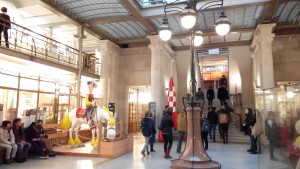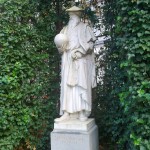- The Cathedral of St Michael and St Gudula – The construction of the cathedral started in the beginning of the 13th century under the leadership of Henry I, Duke of Brabant. Many historical events have taken place in the cathedral, such as the marriage of Prince Philippe and Princess Mathilde in 1999. In front of the cathedral stands a bust of the former King Baudouin.
- The Belgian Comic Strip Museum (Zandstraat 20 – https://www.comicscenter.net/en/home), formerly the Belgian Cartoon Centre, is a museum dedicated to Belgian comic strips. The building was built in 1905 in Art Nouveau style by the famous architect Victor Horta and was originally a department store for Charles Waucquez, a textile merchant.
- The Marc Sleen museum (Zandstraat 33-35 – http://www.marc-sleen.be/en/home ) This museum is about the life and work of the Flemish comic strip artist Marc Sleen (1922 – 2016). The adventures of Nero & Co. is his most important comic strip series.
- The “Petit Sablon” – If you continue your visit to one or more of the museums on the rue de la Régence/ Regentschapsstraat after you have passed through them, direct the courthouse, you will arrive at the “Kleine Zavel/Petit Sablon” on the left. The park was opened in 1890 and is the work of architect Hendrik Beyaert (1823-1894). At regular intervals you will find neo-Gothic columns, with elegant bronze statues representing the Brussels guilds. At the centre is a raised fountain, the circular water basin of which is dominated by the sculpture of the Counts of Egmont and Hoorn. Together with William of Orange, the counts of Egmont and Hoorn played a leading role in the resistance against the king’s rule. These two prominent noblemen who were beheaded shortly after each other on 5 June 1568 on the Grote Markt. They still symbolise the struggle against all forms of intolerance and authoritarian rule.
- Petit Sablon
- The Sablon church
- Petit Sablon
- The Sablon – You cross the street and arrive at the Grote Savel. The Sablon, probably the sand won here in the past, is now known for its many antique shops, restaurants and chocolate shops. Every Sunday morning there is an antique market here.
From the Sablon you quickly reach the Marollenwijk via the Hoogstraat.
- The Marolles and the Hallepoort
In the popular, longest shopping street in Brussels, the Hoogstraat, you’ll find numerous brocante shops and interior design shops. The 16th-century painter Pieter Brueghel the Elder is said to have lived and worked in the building at 132 Hoogstraat. At number 139 you will find the former Jacqmotte coffee roasting house. The Blaesstaat is also a great place to shop.
De Marollen is the oldest working-class neighbourhood in Brussels, situated between the Palace of Justice and the South Station. The name ‘marol’ refers to the Maricollen Sisters or apostolins, a religious order that was present in the district from 1660 to 1715. One of the main characteristics of the Marolles is the social authenticity of the neighbourhood.
In the heart of the Marolles are the Miniemenchurch, the Kapellechurch and the Vossenplein/Place des Jeux de balles, known for the flea and brocant market that takes place daily in the morning.
- Elevator Justice Palace /Marollen
- Antiques and brocante shops
If you walk all the way through the Hoogstraat after your visit to the “Marollenwijk”, you will arrive at the former gate of the city, the Hallepoort.
The Hallepoort was built in 1381 and is the only Brussels city gate that has been preserved. It used to serve as a granary, Lutheran church, prison and archive. Nowadays the Hallepoort is a museum. It gives you an insight into the development of the city, its defence, the various guilds, the Brussels folklore, … (Zuidlaan 150) – http://www.kmkg-mrah.be/halle-gate)
You can continue to the lower city of Brussels, to the upper city or further from the Centre, the choice is yours.








